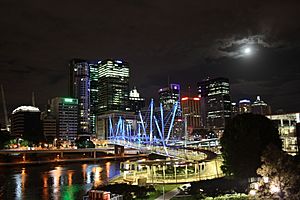Kurilpa Bridge facts for kids
Quick facts for kids Kurilpa Bridge |
|
|---|---|
 |
|
| Carries | Pedestrians and cyclists |
| Crosses | Brisbane River |
| Locale | Brisbane, Queensland, Australia |
| Official name | Kurilpa Bridge |
| Characteristics | |
| Design | Tensegrity cable stay |
| Total length | 470 metres (1,540 ft) |
| Width | 6.5 metres (21 ft) |
| Longest span | 120 metres (390 ft) |
| Clearance below | 11 metres (36 ft) above the bank on the South Bank side |
| History | |
| Engineering design by | Ove Arup & Partners |
| Opened | 4 October 2009 |
The Kurilpa Bridge is a special bridge in Brisbane, Queensland, Australia. It was first called the Tank Street Bridge. This bridge is just for people walking and riding bikes. It cost about A$63 million Australian dollars to build!
The bridge crosses the Brisbane River. It connects Kurilpa Point in South Brisbane to Tank Street in the city center. In 2011, the Kurilpa Bridge was named the World Transport Building of the Year. This award came from the World Architecture Festival.
A company called Baulderstone built the bridge. The people who designed it included Cox Rayner Architects and Arup Engineers. Work on the bridge officially started on 12 December 2007. The bridge was opened on 4 October 2009 by Queensland Premier Anna Bligh.
Contents
How the Kurilpa Bridge Was Built
The Kurilpa Bridge is very unique. It is the world's largest hybrid tensegrity bridge. This means it uses a special design idea called tensegrity. Tensegrity is a way of building things using both strong cables (tension) and stiff poles (compression). These parts work together to make a structure that is light but also incredibly strong.
Bridge Size and Features
The Kurilpa Bridge is 470 metres (1,540 ft) long. Its main section stretches 128 metres (420 ft) across the river. The bridge has two large areas where you can stop to look at the view or relax. There are also two smaller rest spots. A roof covers the entire length of the bridge, keeping you dry in any weather.
About 560 tonnes (620 short tons) of steel was used to build the bridge. This includes 6.8 kilometres (4.2 mi) of special cables. The bridge has 18 steel decks, 20 steel masts (tall poles), and 16 horizontal spars (horizontal poles). There are also 72 concrete slabs that form the main path.
Smart Lighting System
The bridge has a cool lighting system. It uses special LED lights. These lights can be programmed to create many different colors and effects. What's even better is that 75% to 100% of the power for these lights comes from solar energy! This means the bridge often lights up using power from the sun.
How the Bridge Got its Name
A public competition was held to choose a new name for the bridge. On 23 November 2008, the winning name was announced. It was Kurilpa Bridge. Shane Spargo from Nundah, Queensland, suggested this name.
The name "Kurilpa" comes from an Australian Aboriginal word. It refers to the South Brisbane and West End areas. The word "Kurilpa" means "place for water rats".
Images for kids












